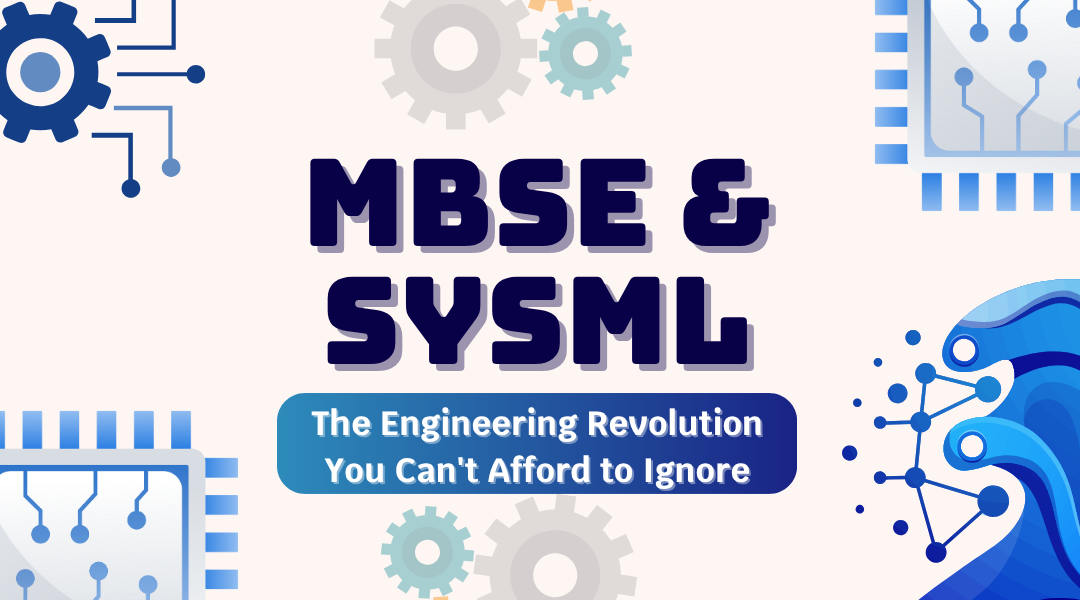The old way of building complex systems is broken. Stacking thousands of disconnected documents, email threads, and spreadsheet requirements is how $100M projects end up as expensive failures. Enter Model-Based Systems Engineering (MBSE) with SysML—not just another buzzword, but a fundamental shift in how we engineer everything from fighter jets to pacemakers.
Why Documents Are Killing Your Projects
The nightmare we’ve all lived:
- Mechanical designs that don’t fit electrical enclosures
- Software that assumes hardware it wasn’t built for
- Safety requirements lost in 300-page PDFs no one reads
MBSE fixes this by:
- Replacing documents with living, interconnected models
- Making inconsistencies visually obvious before fabrication
- Letting you simulate failures before they happen in the real world
SysML: The Language of Systems Thinking
Think of SysML as the engineering equivalent of musical notation—a standardized way to describe complex systems so everyone plays the same tune.
Key diagrams engineers actually use:
- Block Definition Diagrams (BDD)
- Shows components and relationships
- Example: An electric vehicle’s battery pack as a block with properties like capacity: 100kWh, weight: 450kg
- Internal Block Diagrams (IBD)
- Reveals what’s inside those blocks
- Critical for spotting interface mismatches (e.g., CAN bus voltage levels between modules)
- Parametric Diagrams
- Where math meets engineering
- Models constraints like “Motor torque ≥ Vehicle mass × Grade resistance”
- Requirements Diagrams
- Your audit-proof paper trail
- Links “The system shall prevent overheating” to:
- Cooling fan specs
- Temperature sensor placement
- Thermal runaway tests
MBSE in Action: No More “I Thought You Handled That”
Case Study: Autonomous Mining Truck
Old Way:
- Mechanical team designs chassis
- Electrical team routes power
- Software writes control algorithms
- They meet at integration… and the wheel motors overheat because no one modeled the cumulative energy dissipation
MBSE Approach:
- Create system model showing:
- Power demands from all subsystems
- Thermal limits of components
- Failure modes (e.g., “What if two motors fail?”)
- Run simulations to:
- Verify cooling capacity
- Test software fault responses
- Update model continuously as changes occur
Result: Catastrophic failures caught in modeling phase, not at the mining site.
The Hard Truths About MBSE Adoption
What Works:
- Start small: Model one critical subsystem first (e.g., aircraft landing gear)
- Enforce traceability: No requirement gets implemented without a satisfy link
- Live models: Treat the model as the source of truth, not documentation
What Fails:
- “Modeling for modeling’s sake” without tying to real engineering decisions
- Letting the model diverge from the as-built system
- Not training mechanical engineers to read software-oriented diagrams
Tools That Don’t Waste Your Time
For startups:
- Cameo Systems Modeler (affordable)
- Capella (open source)
For enterprise:
- IBM Engineering Systems Design Rhapsody
- Ansys SCADE Architect
Pro tip: Whatever tool you choose, ensure it:
- Handles hardware/software co-design
- Exports to formats your manufacturing team can use
- Tracks change histories for audits
The MBSE Mindset Shift
Successful teams don’t just “do MBSE”—they think differently:
- Model first: Sketch in SysML before CAD or code
- Validate early: Run simulations when changes are cheap
- Trace relentlessly: Every design element must answer “Which requirement does this satisfy?”
When MBSE Pays for Itself
- Regulated industries (medical, aerospace) where audit failures cost millions
- Systems-of-systems (smart cities, defense networks) with 100+ interfaces
- Safety-critical applications where failures endanger lives
ROI example: A defense contractor reduced integration rework by 60% after implementing MBSE—saving $14M on a single program.
Getting Started Without Overwhelm
- Pick one pain point: Maybe requirements traceability or interface management
- Model the “as-is” state: Even flawed models reveal hidden problems
- Automate checks: Validate that all safety requirements have verification links
The Bottom Line
MBSE with SysML isn’t about pretty diagrams—it’s about:
- Preventing expensive integration nightmares
- Proving compliance before regulators ask
- Building systems that actually work as intended
Final test: Can your current process survive a deposition after a system failure? If not, it’s time to go model-based.
Remember: In the age of autonomous systems and AI, winging it with documents isn’t just inefficient—it’s professional malpractice. The future belongs to engineers who can think in systems.
